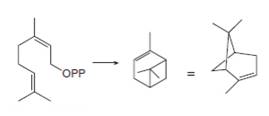
Package: Loose Leaf for Organic Chemistry with Biological Topics with Connect Access Card
5th Edition
ISBN: 9781260170405
Author: SMITH
Publisher: MCG
expand_more
expand_more
format_list_bulleted
Concept explainers
Textbook Question
Chapter 31, Problem 31.30P
Draw a stepwise mechanism for the conversion of neryl diphosphate to

neryl diphosphate
Expert Solution & Answer
Trending nowThis is a popular solution!

Students have asked these similar questions
Draw the skeletal structure of the
alkane 4-ethyl-2, 2, 5, 5-
tetramethylnonane. How many
primary, secondary, tertiary, and
quantenary carbons does it have?
Don't used Ai solution
Don't used Ai solution
Chapter 31 Solutions
Package: Loose Leaf for Organic Chemistry with Biological Topics with Connect Access Card
Ch. 31 - Problem 31.1
One component of jojoba oil is a wax...Ch. 31 - Problem 31.2
How would you expect the melting...Ch. 31 - Problem 31.3
Draw the products formed when...Ch. 31 - Problem 31.4
The main fatty acid component of the...Ch. 31 - Prob. 31.5PCh. 31 - Problem 31.6
Draw the structure of a lecithin...Ch. 31 - Prob. 31.7PCh. 31 - Problem 31.8
Why are phospholipids, but not...Ch. 31 - Problem 31.9
Explain why regularly ingesting a...Ch. 31 - Problem 31.10
Locate the isoprene units in each...
Ch. 31 - Problem 31.11
Locate the isoprene units in...Ch. 31 - Problem 31.12
Write a stepwise mechanism for the...Ch. 31 - Prob. 31.13PCh. 31 - Prob. 31.14PCh. 31 - Prob. 31.15PCh. 31 - Prob. 31.16PCh. 31 - 31.17 Locate the isoprene units in each...Ch. 31 - Prob. 31.18PCh. 31 - Prob. 31.19PCh. 31 - Prob. 31.20PCh. 31 - Prob. 31.21PCh. 31 - 31.22 What is the structure of an optically...Ch. 31 - Prob. 31.23PCh. 31 - 31.24 Draw the structure of the following...Ch. 31 - Prob. 31.25PCh. 31 - Locate the isoprene units in each compound. a. e....Ch. 31 - 31.27 Classify each terpene and terpenoid in...Ch. 31 - 31.38 Draw the products formed when cholesterol is...Ch. 31 - 31.29 An isoprene unit can be thought of as having...Ch. 31 - 31.30 Draw a stepwise mechanism for the conversion...Ch. 31 - Prob. 31.31PCh. 31 - Prob. 31.32PCh. 31 - Draw three-dimensional structures f or each...Ch. 31 - Prob. 31.34PCh. 31 - Prob. 31.35PCh. 31 - Prob. 31.36PCh. 31 - Prob. 31.37PCh. 31 - 31.38 Draw the products formed when cholesterol is...Ch. 31 - 31.39 Draw a stepwise mechanism for the following...Ch. 31 - 31.40 Draw a stepwise mechanism for the following...Ch. 31 - Prob. 31.41P
Knowledge Booster
Learn more about
Need a deep-dive on the concept behind this application? Look no further. Learn more about this topic, chemistry and related others by exploring similar questions and additional content below.Similar questions
- The number of imaginary replicas of a system of N particlesA) can never become infiniteB) can become infiniteC) cannot be greater than Avogadro's numberD) is always greater than Avogadro's number.arrow_forwardElectronic contribution to the heat capacity at constant volume A) is always zero B) is zero, except for excited levels whose energy is comparable to KT C) equals 3/2 Nk D) equals Nk exp(BE)arrow_forwardPlease correct answer and don't used hand raitingarrow_forward
- Calculate the packing factor of CaTiO3. It has a perovskite structure. Data: ionic radii Co²+ = 0.106 nm, Ti4+ = 0.064 nm, O² = 0.132 nm; lattice constant is a = 2(rTi4+ + ro2-). Ca2+ 02- T14+ Consider the ions as rigid spheres. 1. 0.581 or 58.1% 2. -0.581 or -58.1 % 3. 0.254 or 25.4%arrow_forwardGeneral formula etherarrow_forwardPlease provide the retrosynthetic analysis and forward synthesis of the molecule on the left from the starting material on the right. Please include hand-drawn structures! will upvote! Please correct answer and don't used hand raitingarrow_forward
- Please provide the retrosynthetic analysis and forward synthesis of the molecule on the left from the starting material on the right. Please include hand-drawn structures! will upvote!arrow_forward(please correct answer and don't used hand raiting) Please provide the retrosynthetic analysis and forward synthesis of the molecule on the left from the starting material on the right. Please include hand-drawn structures! will upvote!arrow_forwardCaTiO3 has a perovskite structure. Calculate the packing factor.Data: ionic radii Co+2 = 0.106 nm, Ti+4 = 0.064 nm, O-2 = 0.132 nm; lattice constant is a = 2(rTi4+ + rO-2).(a) 0.581(b) -0.581(c) 0.254(d) -0.254arrow_forward
- In the initial linear section of the stress-strain curve of a metal or alloy. Explain from the point of view of atomic structure?(a) No, the atomic level properties of the material can never be related to the linear section.(b) The elastic zone is influenced by the strength of the bonds between atoms.(c) The stronger the bond, the less rigid and the lower the Young's Modulus of the material tested.(d) The stronger the bond, the less stress is necessary to apply to the material to deform it elastically.arrow_forwardThe degree of polymerization of polytetrafluoroethylene (Teflon) is 7500 (mers/mol). If all polymer chains have equal length, state the molecular weight of the polymer and the total number of chains in 1000 g of the polymer(a) 50 000 g/mol; 0.03·1020 chains(b) 100 000 g/mol; 1.03·1020 chains(c) 750 000 g/mol; 8.03·1020 chainsarrow_forwardIn natural rubber or polyisoprene, the trans isomer leads to a higher degree of crystallinity and density than the cis isomer of the same polymer, because(a) it is more symmetrical and regular.(b) it is less symmetrical.(c) it is irregular.arrow_forward
arrow_back_ios
SEE MORE QUESTIONS
arrow_forward_ios
Recommended textbooks for you
 Organic Chemistry: A Guided InquiryChemistryISBN:9780618974122Author:Andrei StraumanisPublisher:Cengage Learning
Organic Chemistry: A Guided InquiryChemistryISBN:9780618974122Author:Andrei StraumanisPublisher:Cengage Learning

Organic Chemistry: A Guided Inquiry
Chemistry
ISBN:9780618974122
Author:Andrei Straumanis
Publisher:Cengage Learning
Lipids - Fatty Acids, Triglycerides, Phospholipids, Terpenes, Waxes, Eicosanoids; Author: The Organic Chemistry Tutor;https://www.youtube.com/watch?v=7dmoH5dAvpY;License: Standard YouTube License, CC-BY